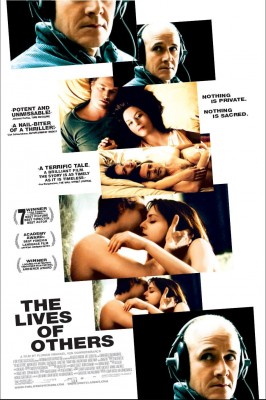 Directed by Florian Henckel von Donnersmarck
Directed by Florian Henckel von Donnersmarck
Written by Florian Henckel von Donnersmarck
Starring Ulrich Mühe, Martina Gedeck, Sebastian Koch, Ulrich Tukur
The one thing stranger than dystopian fiction is dystopian reality.
It’s 1984, and East Germany is known as the German Democratic Republic (or GDR, Deutsche Demokratische Republik). Stasi officer Hauptmann Gerd Wiesler has a very high success rate when it comes to extracting information from rebelling citizens, and he is given the potentially fruitful task of spying on famous playwright Georg Dreyman in order to find behaviour that could be detrimental to Socialism. Wiesler is devoted to his profession and the government, but the surveillance on Dreyman begins to wear away at his previously immovable dedication.
Dreyman is at first a fairly clean-nosed writer who lives happily with his actress girlfriend, Christa-Maria, but soon discovers that she is being forced to have sex with a Stasi officer for an assurance of her safety. On top of this a director friend of his, depressed for having been black-listed by the government from ever working in theatre for an unproven crime, has killed himself. Confused and upset, Dreyman looks into the suicide rates of East Germany only to discover that no records have been published since 1977. The last bits of information that can be found show that Hungary was the only European country to have had a higher number of deaths. Deeply shocked, Dreyman decides that he must write an article on the matter and, as it gets published in a magazine in the West, a man-hunt for the anonymous author of this anti-Socialist piece begins.
The pressure builds for the Stasi to find this mysterious writer before the article becomes too much of a problem and although Wiesler is aware of everything, he is in two minds on whether to report on any of it. He is beginning to feel for the couple who have been thrown into such a deeply unfair situation and as he discovers more about the cruel intentions of his peers, he also starts to admire the couple’s passions and aspirations. He eventually grows to understand their negative reactions to Socialism. It’s almost as if he turns from policeman to fan, and then borders on obsessive stalker.
The film reveals Wiesler’s slow transition from Stasi officer to compassionate human being in such a subtle and gradual way that it is hard not to feel completely immersed as he realises what exactly he has been a part of for all those years. This is also attributed to the perfomances being so genuine and convincing, which again may have been assisted by Ulrich Mühe’s real-life dealings with the Stasi.
The government’s high interest in a single innocent playwright may seem a little far-fetched and pointless, but this sort of thing was very common at the time – especially with artists. Methods such as phone-tapping, apartment-bugging and spying were shockingly rife and there are still millions of Stasi files being sorted through today.
This is what gives the movie such a disturbing edge; a great chunk of this ‘fiction’ is actually reality. It was less than twenty-five years ago when the Berlin Wall finally came down, which basically means anyone above the age of thirty-five who lived in East Germany must remember these sorts of events occurring. We are clearly not as far removed from this sort of fate as we like to think we are.
Orwell warned and warned but still Big Brother was watching over some part of the world in 1984. Nowadays one is more likely to sound like a paranoid loon in raving that the government is out to get us, but we aren’t as independent and free as we initially appear to be. Take the horse meat scandal for instance: a whole country rages as it realises it has been successfully fooled, but what else could we not know about? Dystopian realities have actually occurred during our lifetimes, not hundreds of years ago, not even fifty years ago. In non-Western parts of the world, it is happening right now.
The Lives of Others has really reminded me of how close we actually are to a dystopian reality. Yes, we’ve come a long way in twenty-five years, but how long would it take for this sense of safety to reverse?


Leave a Reply